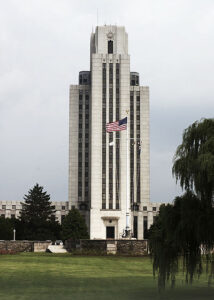Witold Rybczynski's Blog, page 15
October 5, 2020
THE TALENTED MR. CRET
 Perhaps the most televised twentieth-century work of American architecture is the Federal Reserve headquarters (Eccles Building) in Washington, D.C., designed by Paul Philippe Cret (1876-1945) in 1938. Cret’s stripped classical facade inevitably accompanies any report on the Fed on the nightly news. Now Cret has a twofer: Walter Reed National Military Medical Center in Bethesda, where President Trump was taken for treatment of Covid-19. Walter Reed was designed by Cret in 1939-42. It is said that President Roosevelt suggested the twenty-story tower to Cret after visiting Bertram Grosvenor Goodhue’s Nebraska State Capitol. Walter Reed is an example of Cret’s late style, a blend of stripped Classicism and Art Deco. Cret never designed a skyscraper, but this gives a good idea of the direction he might have taken.
Perhaps the most televised twentieth-century work of American architecture is the Federal Reserve headquarters (Eccles Building) in Washington, D.C., designed by Paul Philippe Cret (1876-1945) in 1938. Cret’s stripped classical facade inevitably accompanies any report on the Fed on the nightly news. Now Cret has a twofer: Walter Reed National Military Medical Center in Bethesda, where President Trump was taken for treatment of Covid-19. Walter Reed was designed by Cret in 1939-42. It is said that President Roosevelt suggested the twenty-story tower to Cret after visiting Bertram Grosvenor Goodhue’s Nebraska State Capitol. Walter Reed is an example of Cret’s late style, a blend of stripped Classicism and Art Deco. Cret never designed a skyscraper, but this gives a good idea of the direction he might have taken.
MONSIEUR CRET
 Perhaps the most televised twentieth-century work of American architecture is the Federal Reserve headquarters (Eccles Building) in Washington, D.C., designed by Paul Philippe Cret (1876-1945) in 1938. Cret’s stripped classical facade inevitably accompanies any report on the Fed on the nightly news. Now Cret has a twofer: Walter Reed National Military Medical Center in Bethesda, where President Trump was taken for treatment of Covid-19. Walter Reed was designed by Cret in 1939-42. It is said that President Roosevelt suggested the twenty-story tower to Cret after visiting Bertram Grosvenor Goodhue’s Nebraska State Capitol. Walter Reed is an example of Cret’s late style, a blend of stripped Classicism and Art Deco. Cret never designed a skyscraper, but this gives a good idea of the direction he might have taken.
Perhaps the most televised twentieth-century work of American architecture is the Federal Reserve headquarters (Eccles Building) in Washington, D.C., designed by Paul Philippe Cret (1876-1945) in 1938. Cret’s stripped classical facade inevitably accompanies any report on the Fed on the nightly news. Now Cret has a twofer: Walter Reed National Military Medical Center in Bethesda, where President Trump was taken for treatment of Covid-19. Walter Reed was designed by Cret in 1939-42. It is said that President Roosevelt suggested the twenty-story tower to Cret after visiting Bertram Grosvenor Goodhue’s Nebraska State Capitol. Walter Reed is an example of Cret’s late style, a blend of stripped Classicism and Art Deco. Cret never designed a skyscraper, but this gives a good idea of the direction he might have taken.
October 4, 2020
INFLUENCE
 The cancel culture never sleeps. The discovery that Edward Hopper once copied paintings “challenges the notion that Hopper was an absolute original, uninfluenced by others” according to the breathless headline in the New York Times. A rather silly conclusion since Hopper was sixteen at the time, and was obviously using the paintings of others as an exercise, to hone his—yet unformed—skills. And since neither the technique nor the themes of these pedestrian paintings prefigure his later work, it is a real stretch to speak of “influence.” When I was sixteen I remember clumsily copying Picasso’s “Mirror Woman”; the masonite panel hung in my parents’ basement rec room for years. I was rather proud of it.
The cancel culture never sleeps. The discovery that Edward Hopper once copied paintings “challenges the notion that Hopper was an absolute original, uninfluenced by others” according to the breathless headline in the New York Times. A rather silly conclusion since Hopper was sixteen at the time, and was obviously using the paintings of others as an exercise, to hone his—yet unformed—skills. And since neither the technique nor the themes of these pedestrian paintings prefigure his later work, it is a real stretch to speak of “influence.” When I was sixteen I remember clumsily copying Picasso’s “Mirror Woman”; the masonite panel hung in my parents’ basement rec room for years. I was rather proud of it.
September 12, 2020
THE USUAL SUSPECTS

The City of Philadelphia has announced a $2.2 billion development on the Penn’s Landing site beside the Delaware River. The twelve towers include apartments, offices, and a hotel, the architects are Pelli Clarke Pelli and Bjarke Ingels Group. PCP has already designed high-rise buildings in the city; BIG is a newcomer. Both continue the recent pattern of importing outsiders such as Vinoly, Foster, Gehry, Snøhetta, Williams & Tsien, Pei Cobb Freed, Ennead—the usual suspects. Philadelphia, like most big cities, once had its own stable of eminent practitioners—Strickland, Walter, Furness, Cope & Stewardson, Eyre, Trumbauer, Cret, Howe—and their buildings gave the city its own particular character. That is gone. Now what we get are generic solutions that could be anywhere. The proposed Penn’s Landing buildings will be all-glass, of course.
September 11, 2020
CANCEL CULTURE
 Although some have claimed that the “cancel culture” doesn’t really exist, a nationwide Zogby Analytics poll of likely voters recently found that a narrow plurality (37 percent) supported cancel culture, with 32 percent opposed and 30 percent “not sure.” Some of the poll details are interesting: support was stronger among men than among women, and stronger in the East than in the Midwest; the strongest support was among younger voters, 18-29 and 30-49, whereas the strongest opposition was among voters over 65; and also—surprisingly, at least to me—opposition was strong among the youngest group, 18-24. Self-styled conservative voters were equally split between support and opposition to the cancel culture, whereas 62 percent of progressives voiced support, compared to only 15 percent opposed. It appears that cancel culture (an oxymoron if ever there was one) is fated to be a part of American life for some time to come.
Although some have claimed that the “cancel culture” doesn’t really exist, a nationwide Zogby Analytics poll of likely voters recently found that a narrow plurality (37 percent) supported cancel culture, with 32 percent opposed and 30 percent “not sure.” Some of the poll details are interesting: support was stronger among men than among women, and stronger in the East than in the Midwest; the strongest support was among younger voters, 18-29 and 30-49, whereas the strongest opposition was among voters over 65; and also—surprisingly, at least to me—opposition was strong among the youngest group, 18-24. Self-styled conservative voters were equally split between support and opposition to the cancel culture, whereas 62 percent of progressives voiced support, compared to only 15 percent opposed. It appears that cancel culture (an oxymoron if ever there was one) is fated to be a part of American life for some time to come.
August 10, 2020
WOKE SPEED BUMP
 Museum directors, college deans, and newspaper editors take note.
Museum directors, college deans, and newspaper editors take note.
A few weeks ago a petition spearheaded by a San Francisco Bay Area high school senior was submitted to the Trader Joe’s supermarket company that included the following claim. “The Trader Joe’s branding is racist because it exoticizes [sic] other cultures — it presents ‘Joe’, as the default ‘normal’ and the other characters falling outside of it … The common thread between all of these transgressions is the perpetuation of exoticism, the goal of which is not to appreciate other cultures, but to further other and distance them from the perceived ‘normal.’” These days such statements are followed by steely-eyed demands, and these days most companies and institutions comply.
Trader Joe’s response? “A few weeks ago, an online petition was launched calling on us to ‘remove racist packaging from [our] products.’ Following were inaccurate reports that the petition prompted us to take action. We want to be clear: we disagree that any of these labels are racist. We do not make decisions based on petitions.”
As a dedicated TJ shopper I say, “Good for them.”
WOKENESS SPEED BUMP
 Museum directors, college deans, and newspaper editors take note.
Museum directors, college deans, and newspaper editors take note.
A few weeks ago a petition spearheaded by a San Francisco Bay Area high school senior was submitted to the Trader Joe’s supermarket company that included the following claim. “The Trader Joe’s branding is racist because it exoticizes [sic] other cultures — it presents ‘Joe’, as the default ‘normal’ and the other characters falling outside of it … The common thread between all of these transgressions is the perpetuation of exoticism, the goal of which is not to appreciate other cultures, but to further other and distance them from the perceived ‘normal.’” These days such statements are followed by steely-eyed demands, and these days most companies and institutions comply.
Trader Joe’s response? “A few weeks ago, an online petition was launched calling on us to ‘remove racist packaging from [our] products.’ Following were inaccurate reports that the petition prompted us to take action. We want to be clear: we disagree that any of these labels are racist. We do not make decisions based on petitions.”
As a dedicated TJ shopper I say, “Good for them.”
August 1, 2020
THE WAY WE LIVE TODAY

Carving, Charles Joseph
I am a latecomer to the Jordan Peterson phenomenon. I haven’t read any of his books but I have listened to numerous lectures and interviews. A 2018 interview with NYU professor Jonathan Hardt, founder of the Heterodox Academy, about the causes for the unravelling of the contemporary university touched me close to home. Peterson appeared on the social media battlefield after involving himself in a free speech controversy with the University of Toronto, his employer. Peterson’s views have made him a lightning rod for radical left-wing critics who have trotted out the usual accusations: hate-speech mongerer, fascist, racist, white supremacist. Peterson collects native Canadian art from coastal British Columbia, and has formed a friendship with Charles Joseph, an accomplished Kwakwaka’wakw carver from the Ma’amtaglia-Tlowitsis tribe. In a blanketing ceremony Peterson was given a Kwak’wala name and made an honorary member of Joseph’s family. Unexpected for a racist-white supremacist.
July 16, 2020
COSY GLASS BOX

Photo: William Zbaren
The current exhibition at the Farnsworth House gets rid of all the Mies furniture, which was never a part of the original decor, and recreates the interior as it was when when Dr. Farnsworth actually lived in the house. There are Moroccan rugs on the travertine floor, and wooden chairs and chaises longues—mostly Scandinavian (Risom, Matthson, Wegner), although the curators didn’t hang stuff on the pristine primavera as the good doctor did. I notice that she turned the freestanding closet ninety degrees to create a more intimate bedroom (there is such a thing as too much glass). The result is a revelation—the house is, if not cosy, at least humane. A home, not a shrine to the architect. I hope they keep it that way.
July 4, 2020
WHAT’S NEXT
 Last week, the University of Pennsylvania announced plans to remove its statue of George Whitefield, a famous eighteenth-century British preacher, due to his condoning slavery. What was the statue, made by R. Tait McKenzie in 1919, doing at Penn? Whitefield was a lifelong friend of Benjamin Franklin, the founder of the university. Moreover, as the Penn website notes: “Franklin chose the Whitefield meeting house, with its Charity School, to be purchased as the site of the newly formed Academy of Philadelphia which opened in 1751, followed in 1755 with the College of Philadelphia, both the predecessors of the University of Pennsylvania.” Apparently Franklin, who published several of the preacher’s texts, was more tolerant than his successors. But the mob has its own reasons, or in this case putative reasons, for Penn’s action appears to have been preventative. Whitefield had to go. But what’s next? Architecture often assumes a commemorative function, must it, too, be cancelled in this misbegotten attempt to rewrite history? If Jefferson and Washington are suspect, what about their homes, Monticello and Mount Vernon. To make matters worse, the houses were built with slave labor. The architecture of both was influenced by the prevailing eighteenth-century fashion for Classicism, a style that originated in ancient Rome and Greece. Both were slave-owning societies, so no doubt temple pediments and Ionic columns will sooner or later be called into question, too.
Last week, the University of Pennsylvania announced plans to remove its statue of George Whitefield, a famous eighteenth-century British preacher, due to his condoning slavery. What was the statue, made by R. Tait McKenzie in 1919, doing at Penn? Whitefield was a lifelong friend of Benjamin Franklin, the founder of the university. Moreover, as the Penn website notes: “Franklin chose the Whitefield meeting house, with its Charity School, to be purchased as the site of the newly formed Academy of Philadelphia which opened in 1751, followed in 1755 with the College of Philadelphia, both the predecessors of the University of Pennsylvania.” Apparently Franklin, who published several of the preacher’s texts, was more tolerant than his successors. But the mob has its own reasons, or in this case putative reasons, for Penn’s action appears to have been preventative. Whitefield had to go. But what’s next? Architecture often assumes a commemorative function, must it, too, be cancelled in this misbegotten attempt to rewrite history? If Jefferson and Washington are suspect, what about their homes, Monticello and Mount Vernon. To make matters worse, the houses were built with slave labor. The architecture of both was influenced by the prevailing eighteenth-century fashion for Classicism, a style that originated in ancient Rome and Greece. Both were slave-owning societies, so no doubt temple pediments and Ionic columns will sooner or later be called into question, too.
Witold Rybczynski's Blog
- Witold Rybczynski's profile
- 178 followers



